This week’s space-shattering announcement by Berkeley scientists that the Milky Way is chock full of “Earth-like” planets capable of sustaining water—and thus possibly life—provoked a virtual meteor shower of coverage coast-to-coast. Cal’s team, led by graduate student Erik Petigura, based its discovery on a three-year analysis of data from NASA’s Kepler spacecraft, and it seems clear that, in Petigura’s words, the universe has produced “plentiful real estate for life that somehow resembles life on earth.”
But although everyone seemed to agree that the finding was big news, nobody could agree on the number of such planets there. Depending on the major news source, the reported estimates of habitable Earth-like planets ranged from about 4 billion to about 40 billion.
Even given the vast expanse of space, that’s a heck of a lot of wiggle room.
The Columbia Journalism Review attempts to do the math, and resolve the discrepencies, here.


















